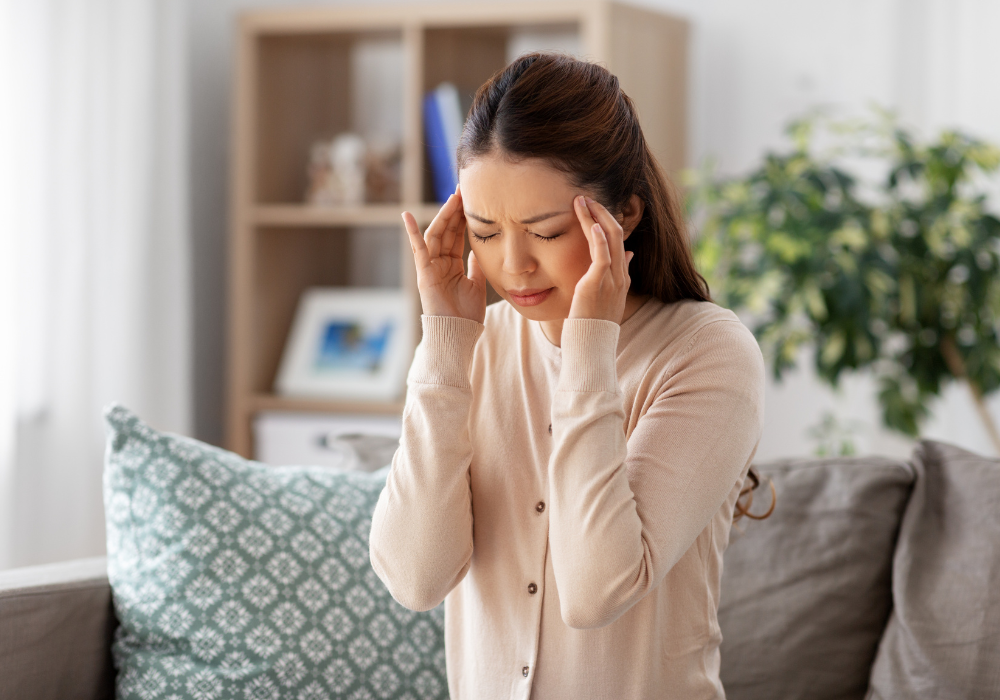Headaches
Move Better. Live Fuller. Your Wellness Journey Starts Here.
Schedule a FREE Discovery Call!
[rank_math_breadcrumb]
About Headaches
Headaches are a very common condition that affects people worldwide. Simply put, they are characterized by pain in any region of the head. However, not all headaches are the same. They can vary by severity, cause, type, duration, and symptoms.
Headaches may occur on one or both sides of the head, be isolated to a certain location, radiate across the head from one point, or be abnormal in pattern. The pain can be sharp, throbbing, dull, and may appear gradually or suddenly. They can last for less than an hour or up to several days. There are also different types of headaches, which can be better characterized by the type of pain, location of the pain, and its possible cause.

Some different types of headaches include:
- Tension Headaches
- These are the most common type, characterized by a dull, aching pain and tightness around the forehead, back of the head, and neck. They can be caused by muscle tension and poor joint mobility in these areas, often due to stress or poor posture.
- Physical therapy can help with tension headaches by teaching exercises to improve posture, reduce muscle tension, and enhance neck mobility. Additionally, physical therapy can employ various hands-on techniques, including dry needling and joint mobilization, to minimize pain, improve alignment, and increase overall muscle tone.
- Migraines
- While migraines are primarily a neurological condition, some people may experience musculoskeletal issues contributing to their symptoms. These symptoms can include tightness or dysfunction in the neck and shoulder muscles or joints.
- In these cases, physical therapy may help reduce the frequency and intensity of migraines by addressing these musculoskeletal factors with manual therapy, dry needling, and cupping.
- Post-Traumatic Headaches
- This is a type of headache that forms following a head or neck injury, such as a concussion or whiplash.
- Physical therapy can assist in the rehabilitation process by helping to restore normal function and reduce symptoms through specific exercises, manual therapy, behavioral modifications, and education on pain management strategies.
- Cervicogenic Headaches
- These originate from neck disorders and are often the result of cervical spine problems such as disc degeneration, neck injuries, or arthritis. Symptoms can include pain on one side of the head or face, stiffness in the neck, and pain that worsens with certain neck movements.
- Physical therapists can use manual therapy techniques, neck exercises, and other treatments to alleviate the symptoms.
Symptoms and Causes of Headaches
Because headaches can vary widely and have a variety of causes, symptoms will vary from person to person. Some individuals may even experience multiple symptoms at one time. These symptoms can also feel more intense with migraines. Some common symptoms include:
- Pain: The most obvious symptom is pain. It can vary in intensity, location, and duration and can be described as dull, throbbing, sharp, or constant.
- Sensitivity: Many may experience increased sensitivity to bright lights and loud sounds, particularly with migraines.
- Sensitivity to smells: Some may find certain smells particularly bothersome or a possible trigger for their headaches.
- Nausea: Nausea and vomiting are more commonly associated with migraines but can also occur with other types of headaches.
- Blurred vision: Some individuals may experience visual disturbances, including blurred vision or visual auras (described as seeing flashes of light or zig-zag patterns).
- Lightheadedness: Dizziness or being faint.
- Neck pain and stiffness: More common in tension and cervicogenic headaches, where the pain can originate or extend to the neck area.
- Nasal congestion and runny nose: These are usually more common with cluster and sinus headaches, which are related to sinus problems.
- Irritability and fatigue: This condition can affect mood and energy levels, causing feelings of tiredness or irritability.
- Difficulty concentrating: Pain and discomfort can make it hard to focus or think clearly.
Possible Causes:
- Infection
- Medications
- Hormones
- Disorder of the nervous system, ear, nose, or throat
- High blood pressure
- Arthritis
- Noise
- Temperature
- And more
Causes Treatable With Physical Therapy:
- Stress
- Poor posture
- Lack of sleep or irregular sleep patterns
- Dehydration
- Poor diet
- Caffeine withdrawal
- Alcohol consumption
- Trauma or injury
- High blood pressure
Physical Therapy for Headaches
Your physical therapist will use a distinct approach to identify musculoskeletal contributions to symptoms and determine the most appropriate physical therapy treatment. The evaluation process may include the following factors:
- Medical History Overview
- Your provider should always start by thoroughly discussing your medical history and experiences with headaches. This includes examining your usual symptoms, their duration, severity, frequency, location, and possible triggers.
- They will also want to know about any previous injuries, surgeries, or previous treatments. They may also ask about your posture, diet, and other lifestyle factors.
- Posture Assessment:
- Poor posture can contribute to tension and cervicogenic headaches. Therefore, your physical therapist will evaluate your posture during both sitting and standing positions.
- Cervical Mobility Assessment:
- This is an assessment of your neck’s range of motion and flexibility to identify any restrictions or asymmetries that might contribute to symptoms.
- Manual Examination:
- Your provider will palpate the cervical spine, skull, and surrounding musculature (such as the suboccipital, temporal, and shoulder muscles) to identify areas of tenderness, muscle tightness, or trigger points.
- Neurological Screening:
- Your physical therapist may perform basic screening tests for reflexes, strength, sensation, and coordination to rule out neurological causes.
- Special Tests:
- Special tests may be used to further evaluate the cervical spine and its potential role in your symptoms. These can help identify specific contributing factors.
- Assessment of Functional Limitations:
- Your physical therapist will assess how your symptoms affect your daily activities and overall quality of life—including work, sleep, and recreational activities.
- Other Factors:
- Your provider may also consider other factors contributing to symptoms, such as stress, diet, hydration, and exercise habits.
Based on their findings from the above-mentioned steps, your provider will develop a diagnosis regarding the type of headache and the contributing factors. While physical therapists can diagnose musculoskeletal contributions and provide effective treatment, headaches with unknown causes or symptoms suggesting a more serious condition (such as sudden or severe onset, neurological deficits, or systemic symptoms) should be evaluated by a physician to rule out other underlying medical conditions.
Treatment will vary depending on your personal symptoms and headache type. As mentioned before, physical therapy can help to improve posture and muscle strength, while also focusing on reducing muscle tension and stiffness. Physical therapists will help educate you on possible triggers and relaxation techniques to use at home. Some specific physical therapy treatments your provider may choose for managing symptoms can include:
- Dry Needling
- Cupping
- Manual Therapy
- Spinal Manipulation
- Electrical Muscle Stimulation
- Tissue Scraping
- Exercise Prescription
- Behavioral Modifications
- Therapeutic Modalities
- Neuromuscular Re-education
- Biofeedback (part of neuromuscular)
- Therapeutic Activity
Headaches are a very common condition that affects people worldwide. Simply put, they are characterized by pain in any region of the head. However, not all headaches are the same. They can vary by severity, cause, type, duration, and symptoms.
Headaches may occur on one or both sides of the head, be isolated to a certain location, radiate across the head from one point, or be abnormal in pattern. The pain can be sharp, throbbing, dull, and may appear gradually or suddenly. They can last for less than an hour or up to several days.
There are also different types of headaches, which can be better characterized by the type of pain, location of the pain, and possible causes of the pain. Some different types of headaches include:
- Tension Headaches
- These are the most common type, characterized by a dull, aching pain and tightness around the forehead, back of the head, and neck. They can be caused by muscle tension and poor joint mobility in these areas, often due to stress or poor posture.
- Physical therapy can help with tension headaches by teaching exercises to improve posture, reduce muscle tension, and enhance neck mobility. Additionally, physical therapy can employ various hands-on techniques, including dry needling and joint mobilization, to minimize pain, improve alignment, and increase overall muscle tone.
- Migraines
- While migraines are primarily a neurological condition, some people may experience musculoskeletal issues contributing to their symptoms. These symptoms can include tightness or dysfunction in the neck and shoulder muscles or joints.
- In these cases, physical therapy may help reduce the frequency and intensity of migraines by addressing these musculoskeletal factors with manual therapy, dry needling, and cupping.
- Post-Traumatic Headaches
- This is a type of headache that forms following a head or neck injury, such as a concussion or whiplash.
- Physical therapy can assist in the rehabilitation process by helping to restore normal function and reduce symptoms through specific exercises, manual therapy, behavioral modifications, and education on pain management strategies.
- Cervicogenic Headaches
- These originate from neck disorders and are often the result of cervical spine problems such as disc degeneration, neck injuries, or arthritis. Symptoms can include pain on one side of the head or face, stiffness in the neck, and pain that worsens with certain neck movements.
- Physical therapists can use manual therapy techniques, neck exercises, and other treatments to alleviate the symptoms.
Because headaches can vary widely and have a variety of causes, symptoms will vary from person to person. Some individuals may even experience multiple symptoms at one time. These symptoms can also feel more intense with migraines. Some common symptoms include:
- Pain: The most obvious symptom is pain. It can vary in intensity, location, and duration and can be described as dull, throbbing, sharp, or constant.
- Sensitivity: Many may experience increased sensitivity to bright lights and loud sounds, particularly with migraines.
- Sensitivity to smells: Some may find certain smells particularly bothersome or a possible trigger for their headaches.
- Nausea: Nausea and vomiting are more commonly associated with migraines but can also occur with other types of headaches.
- Blurred vision: Some individuals may experience visual disturbances, including blurred vision or visual auras (described as seeing flashes of light or zig-zag patterns).
- Lightheadedness: Dizziness or being faint.
- Neck pain and stiffness: More common in tension and cervicogenic headaches, where the pain can originate or extend to the neck area.
- Nasal congestion and runny nose: These are usually more common with cluster and sinus headaches, which are related to sinus problems.
- Irritability and fatigue: This condition can affect mood and energy levels, causing feelings of tiredness or irritability.
- Difficulty concentrating: Pain and discomfort can make it hard to focus or think clearly.
Possible Causes:
- Infection
- Medications
- Hormones
- Disorder of the nervous system, ear, nose, or throat
- High blood pressure
- Arthritis
- Noise
- Temperature
- And more
Causes Treatable With Physical Therapy:
- Stress
- Poor posture
- Lack of sleep or irregular sleep patterns
- Dehydration
- Poor diet
- Caffeine withdrawal
- Alcohol consumption
- Trauma or injury
- High blood pressure
Your physical therapist will use a distinct approach to identify musculoskeletal contributions to symptoms and determine the most appropriate physical therapy treatment. The evaluation process may include the following factors:
- Medical History Overview
- Your provider should always start by thoroughly discussing your medical history and experiences with headaches. This includes examining your usual symptoms, their duration, severity, frequency, location, and possible triggers.
- They will also want to know about any previous injuries, surgeries, or previous treatments. They may also ask about your posture, diet, and other lifestyle factors.
- Posture Assessment:
- Poor posture can contribute to tension and cervicogenic headaches. Therefore, your physical therapist will evaluate your posture during both sitting and standing positions.
- Cervical Mobility Assessment:
- This is an assessment of your neck’s range of motion and flexibility to identify any restrictions or asymmetries that might contribute to symptoms.
- Manual Examination:
- Your provider will palpate the cervical spine, skull, and surrounding musculature (such as the suboccipital, temporal, and shoulder muscles) to identify areas of tenderness, muscle tightness, or trigger points.
- Neurological Screening:
- Your physical therapist may perform basic screening tests for reflexes, strength, sensation, and coordination to rule out neurological causes.
- Special Tests:
- Special tests may be used to further evaluate the cervical spine and its potential role in your symptoms. These can help identify specific contributing factors.
- Assessment of Functional Limitations:
- Your physical therapist will assess how your symptoms affect your daily activities and overall quality of life—including work, sleep, and recreational activities.
- Other Factors:
- Your provider may also consider other factors contributing to symptoms, such as stress, diet, hydration, and exercise habits.
Based on their findings from the above-mentioned steps, your provider will develop a diagnosis regarding the type of headache and the contributing factors.
While physical therapists can diagnose musculoskeletal contributions and provide effective treatment, headaches with unknown causes or symptoms suggesting a more serious condition (such as sudden or severe onset, neurological deficits, or systemic symptoms) should be evaluated by a physician to rule out other underlying medical conditions.
Treatment will vary depending on your personal symptoms and headache type. As mentioned before, physical therapy can help to improve posture and muscle strength, while also focusing on reducing muscle tension and stiffness.
Physical therapists will help educate you on possible triggers and relaxation techniques to use at home. Some specific physical therapy treatments your provider may choose for managing symptoms can include:
- Dry Needling
- Cupping
- Manual Therapy
- Spinal Manipulation
- Electrical Muscle Stimulation
- Tissue Scraping
- Exercise Prescription
- Behavioral Modifications
- Therapeutic Modalities
- Neuromuscular Re-education
- Biofeedback (part of neuromuscular)
- Therapeutic Activity
You can learn more about these treatments on our Treatments Page.





